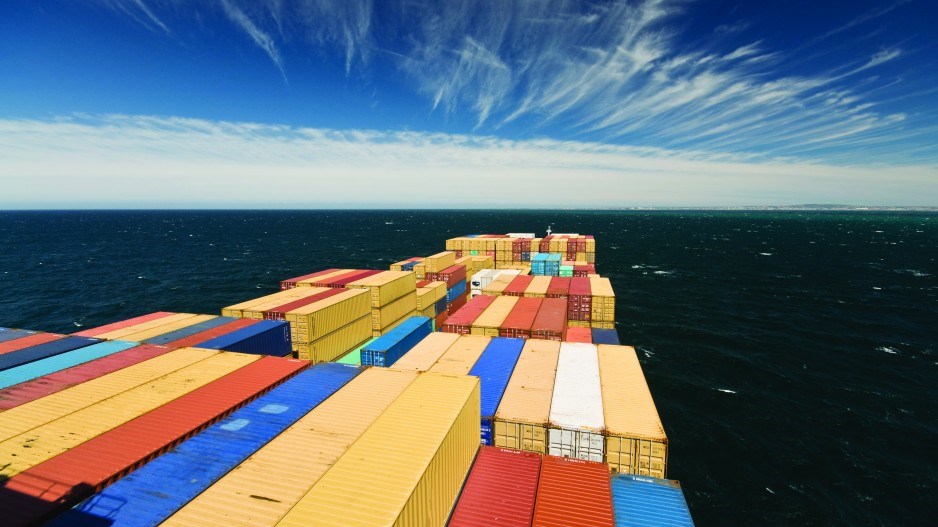The marine forecast is for more rough weather ahead in the cutthroat global container shipping sector, but a Vancouver supplier of container ships to major shipping lines is staying its course of long-term expansion.
Drewry, a U.K.-based shipping consultancy, noted in a recent Container Insight Weekly dispatch that record container ship capacity was added in 2015 to an already oversupplied pool of container ships.
Capacity of approximately 1.7 million TEU (20-foot equivalent units) joined a global fleet operating in a marketplace with severely depressed container shipping rates. Earlier this year those rates fell to a record low, according to the World Container Index.
Drewry also pointed out that fewer ships were scrapped in 2015, further widening the supply-and-demand gap in favour of container users.
The combination of more capacity and slowing economies in Asia has increased the percentage of container ships sitting idle and placed container shipping lines in tenuous financial situations all over the globe.
Good for exporters and importers, perhaps, but bad for container shipping suppliers.
Seaspan Corp. (NYSE:SSW) is one of those suppliers. The former Seaspan Container Lines has no business relationship with North Vancouver-based shipbuilder Seaspan Marine Corp. However, the co-chairman of Seaspan Corp.’s board is Kyle Washington, the eldest son of Dennis Washington, founder of the Washington family business empire, which has ownership interests in Seaspan Corp. and Seaspan Marine Corp.
Seaspan Corp., which has an office in Vancouver, leases container ships to major shipping lines all over the world.
It’s a high-stakes business.
Thus far, however, Seaspan Corp. appears to be doing all right. Since going public in 2005 with a fleet of 10 container ships, it has become the world’s largest independent container ship lease company.
With a market capitalization of close to US$2 billion, it has approximately US$6 billion in long-term contracts to lease container ships to major deepwater carriers, including Maersk Line (CO:MAERSK-B), the world’s biggest container ship operator, and Hapag-Lloyd (GR:HPL), Germany’s largest shipping company.
Seaspan Corp., which reported revenue of US$819 million in fiscal 2015, a 14.2% increase over 2014, now has a fleet of more than 100 container ships and a staff of approximately 3,000.
As of February, it had contracted to buy nine new container ships. The corporation has US$667 million in costs remaining to pay on its fleet.
But the outlook for its customer base is far from bright.
Last November, Maersk announced plans to cut 4,000 positions from its land-based staff of 23,000 by the end of 2017 because of the rapidly deteriorating container-shipping marketplace.
Maersk reported a profit of US$1.3 billion in 2015, but that was down 44% from 2014’s US$2.3 billion.
Based on its survey of 400 ports worldwide, global container data company Alphaliner reported earlier this year that container port throughput grew by a mere 1.1% in 2015, the second-lowest growth rate recorded by the industry.
Many shipping lines, especially Chinese companies, are consequently struggling to survive.
According to a Seatrade report, Kawasaki Kisen Kaisha (K Line) chairman Jiro Asakura warned attendees at the Sea Japan 2016 conference that the market for dry bulk carriers is set to fall to “inconceivable” levels in 2016.
The risks presented by the glut of freighter capacity are not lost on Seaspan.
The company’s 2015 annual filing with the U.S. Securities and Exchange Commission includes an inventory of challenges facing it and the global container shipping sector.
Foremost among them: too many ships chasing too few containers. As of February, the aggregate capacity of new container ships under construction was around 3.9 million TEU – roughly 20% of the current global total.
Overcapacity also erodes charter hire opportunities. Many of Seaspan’s ships are leased to customers in the financially troubled Chinese market; it also uses shipbuilders based in China.
The legal landscape in the Asian country is far from clear, especially when it comes to massive corporate consolidation, mergers or bankruptcies of customers and shipbuilding suppliers.
Seaspan is also carrying significant debt – roughly US$3.4 billion as of December 31.
During the earnings period prior to the release of its most recent quarterly financials, Seaspan’s executive team declined to comment on marketplace challenges or its business strategy of securing long-term container leasing contracts of between 10 and 12 years rather than pursuing spot market opportunities.
The company’s first-quarter 2016 financial results, released April 25, showed Seaspan revenue up 14.3% to US$215.5 million compared with the same quarter in 2015. However, reported net earnings were down 67% to US$7.1 million.
According to a statement in Seaspan’s fourth-quarter 2015 financial report, CEO Gerry Wang said the company had raised roughly US$1.4 billion in proceeds from capital and financing transactions during 2015 and achieved an important milestone by expanding its fleet to more than 100 vessels.
Analysts also like Seaspan’s game plan.
Kevin Sterling, a research analyst with Richmond, Virginia’s BB&T Capital Markets, said Seaspan has done an admirable job of picking high-quality long-term lease customers for its container ships.
“Even in the great recession in 2008-09, I think they maybe only had one lease broken, which is pretty impressive when the world was falling apart.”
But Sterling agreed that the near-term outlook for the container shipping sector globally is grim.
“There are going to be storm clouds on the horizon because … I still think we’re oversupplied.”
However, he remained bullish on Seaspan’s prospects because of the company’s ability to cultivate good, reliable clientele.
“I think very highly of them; they are probably one of the prettier houses in an ugly neighbourhood.”
Check out BIV’s podcast for the week of April 25, 2016:




